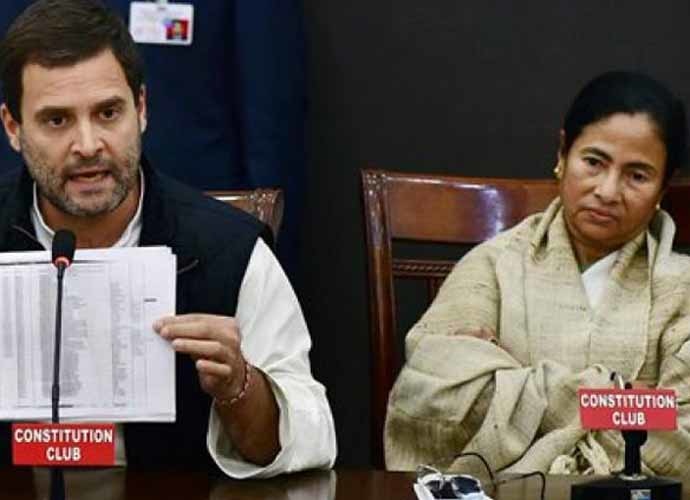Why too many PM aspirants will break Opposition unity from within

When BSP president Mayawati leant forward to touch foreheads with UPA chairperson Sonia Gandhi, as Trinamool Congress chief Mamata Banerjee looked benignly on in front of a gaggle of Opposition leaders gathered in Bengaluru to attend HD Kumaraswamy’s swearing-in as chief minister of Karnataka, few could have read what was passing through the Dalit leader’s mind.
Mission 2019
Two days later, it couldn’t have been clearer. On the eve of the BSP’s national executive committee on May 26, a senior BSP leader declared emphatically: “Mayawati will be prime minister of a united Opposition front government in 2019.”
Prime Minister Mayawati in 2019? The BSP does not have a single MP in the 545- seat Lok Sabha. Mayawati herself faces CBI investigations in a slew of corruption cases. Yet she regards herself as a serious contender for the prime ministership next year.
Mamata Banerjee, having successfully polarised West Bengal during the blood-soaked panchayat elections, harbours prime ministerial ambitions of her own. She can’t have been pleased by Mayawati throwing her hat so early into the ring.
There are others who will gnash their teeth silently. Telangana chief minister K Chandrashekar Rao, who has national ambitions as well, tried to persuade Banerjee to create an alternative non-NDA, non-UPA federal front. He didn’t bother to turn up at Kumaraswamy’s swearing-in, though Bengaluru is a short flight from Hyderabad.
Another notable absentee: Odisha chief minister Naveen Patnaik who fears the BJP is making deep inroads into his state. He backs KCR’s federal front and is prepared for a shot at the prime ministership if the dice falls in his favour.
Observing all this is the original Chanakya, Sharad Pawar, playing the role of master of ceremonies to the disparate group of Opposition leaders, hoping that if consensus among them fails to throw up a suitable prime minister in the evolving grand alliance, then with his vast resources and network he could offer himself as a compromise candidate.
Meanwhile, former Uttar Pradesh chief minister Akhilesh Yadav has decided to bide his time even though his party wants to project him as the face of the anti-Modi front and a consensus prime minister in 2019.
If the SP’s alliance with the BSP gives the combine over 40 of UP’s 80 Lok Sabha seats in 2019, Akhilesh will target the UP Assembly elections in 2022 to return as chief minister with the BSP as alliance partner in the assembly and Mayawati safely tucked away in Delhi, busy with her national ambitions. At 44, Akhilesh can afford to wait for a move from Lucknow to Delhi.
Lost amidst the regional leaders jostling for space is Rahul Gandhi, who has one eye fixed on 2019 and the other on 2024. If it hadn’t been for his quick decision to offer “unconditional” support to the JD(S) and back Kumaraswamy as chief minister, Karnataka could have fallen to the BJP.
That support is now under severe coalition test. Rahul, as the leader of the largest Opposition party with 48 Lok Sabha MPs, finds himself strangely at odds with the very regional satraps whose support he needs to be prime minister.

Rahul’s dilemma
Does Rahul have that support? It will depend on the numbers the Congress racks up in 2019. Anything less than 100 Lok Sabha seats will weaken his prospects. In such a situation, Rahul can at best reprise the 1996 United Front (UF) experiment when the Congress-supported Deve Gowda’s multi-party UF alliance from outside. As the largest (though with sub-100 seats) party, can Rahul insist on being prime minister? Unlikely, with Mamata pressing her claim too. Banerjee’s relationship with Sonia is warm, but with Rahul it is at best lukewarm.
Amidst all this fluctuating chemistry, how might the numbers in 2019 stack up? According to one analysis of India’s 36 states and union territories, a grand alliance between regional parties will cost the BJP 46 seats in UP, four seats in Madhya Pradesh, two seats each in Karnataka, Assam and Chhattisgarh, and one seat each in Punjab and Jharkhand.
There would be gains in Bihar, Odisha and parts of the northeast. Overall, the BJP could lose around 55-60 seats from its 2014 tally, dropping to 225 seats.
Two scenarios
Scenario 1: If the BJP wins more than 225 seats, it will scramble to form a government with NDA allies and independents. Such a government, dubbed Modi 2.0, could last its full term but will need to manage allies more sensitively.
Scenario 2: If the BJP wins between 180 and 200 seats, the Congress garners over 100 seats and regional parties win over 150 seats between them (principally the TMC, SP, BSP, DMK, JD(S), NCP and the Left), the BJP will have to sit in the Opposition while the Congress and its grand alliance partners work out their differences over who will be prime minister.
A spell in the Opposition will do the BJP a world of good. It will be able to ponder the missteps of its five-year tenure. After experiencing a few years of Rahul, Mayawati, Mamata, Akhilesh or Pawar as prime minister, the cry to bring Modi back could well erupt as it did for Vajpayee in 1998 after the UF government, under the late Prime Minister IK Gujral, collapsed when the Congress, true to type, for the second time in nine months, withdrew its support. History has an awkward habit of repeating itself.
(Courtesy of Mail Today)

